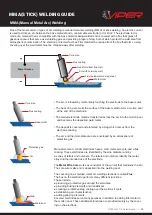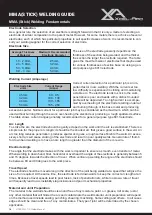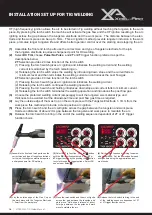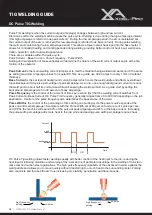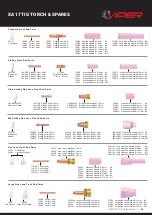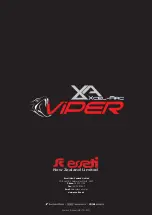
Gas Flow Regulators
The job of the gas flow regulator is to reduce the bottle pressure gas down to a lower pressure and deliver it at a constant flow. This constant flow of gas
is usually fed through the welding machine where it is controlled by a solenoid valve, operated when the torch trigger is pulled. Once the gas has passed
the solenoid valve it flows down the torch cable exiting at the gas nozzle to protect the weld pool and surrounding area. There are two main types of flow
regulators commonly used for MIG and TIG welding applications. Both regulator types perform the same function, but have a different way of setting and
measuring the gas flow. A flow-gauge regulator (Fig.1) has a dial-type pressure gauge to measure the cylinder contents and a second gauge to measure
and deliver the flow rate required.The flow-meter regulator (Fig.2) has a pressure gauge to measure the cylinder contents and a flow tube assembly to
measure and deliver the flow rate required. Some flowmeter regulators will have two flow tube assemblies (Fig.3) typically one is used for supplying
gas to the welding machine and the other is used used for purging the welding area with gas prior to welding, during welding and post welding and at a
separate rate of flow from that being supplied to the welding machine. The amount of gas flow needed to do the job will depend on the welding gas and
the job being done, but a common setting to start with is 10 L/min.
Shielding Gases
Shielding gases are almost always necessary for MIG and TIG welding processes to protect the weld zone from gases that are contained in the
surrounding atmosphere, particularly nitrogen and oxygen. If allowed into the weld zone these gases will contaminate the weld pool resulting in fusion
defects also porosity and embrittlement of the weld metal. Selecting the right type of shielding gas depends on the welding process being used and type
of material being welded. The MIG process is typically a mixture of Argon and Co2 (AR90% Co2 10%) or pure Co2 for steel welding applications, other
specialised mixtures of Argon, Co2, and Oxygen are available for stainless steel welding but with welding aluminium pure Argon is almost always used
The TIG welding process almost always requires 100% Argon for welding of all materials, however in some specialised applications Helium, or a Helium
mix are sometimes used. Today with the multitude of gas mixes available through a number of different suppliers, it is difficult to list and recommend
which gas mix is better for which job. If you are unsure about what gas or gas mix to use we recommend you discuss with your application local gas
suppliers or your Esseti technical representative.
Fig.1
Fig.2
Fig.3
VIPER 200P TIG Welder Manual |
27
GAS FLOW REGULATORS - SHEILDING GASES
Содержание VIPER TIG 200P
Страница 34: ... 34 VIPER 200P TIG Welder Manual NOTES ...
Страница 35: ... VIPER 200P TIG Welder Manual 35 NOTES ...

